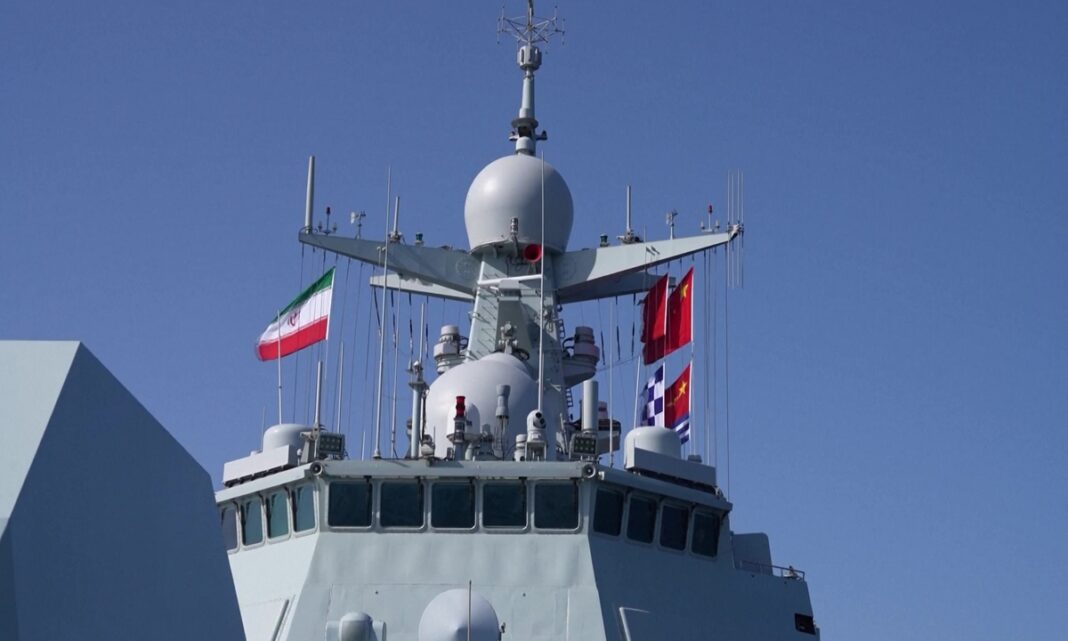A major military drill involving the naval forces of Iran, Russia, and China is currently taking place in the northern Indian Ocean near the Gulf of Oman. These exercises, which began on Tuesday, are being held to strengthen military cooperation and enhance regional security. The event is being hosted in the port of Chabahar, a key Iranian coastal city in the southeastern part of the country.
Massive Naval Exercises Begin in the Indian Ocean
Chabahar is strategically important as it provides access to international shipping routes in the Indian Ocean. This makes it a valuable location for military drills, allowing participating navies to practice maritime operations in a region critical to global trade. The naval forces of Iran, including both the army and the Revolutionary Guards, are actively involved alongside warships and support vessels from Russia and China.
This military exercise is not limited to the three main participants. Several other countries, including Azerbaijan, South Africa, Oman, Kazakhstan, Pakistan, Qatar, Iraq, the United Arab Emirates, and Sri Lanka, have sent military representatives to observe the drills. Their presence highlights the broader international interest in Indian Ocean naval security and military cooperation in the region.
A Show of Strength and Tactical Coordination
Iran, Russia, and China have conducted similar naval exercises in recent years, particularly in the Indian Ocean. These drills are seen as a way for these countries to strengthen their military ties and counter the influence of foreign powers in the region. By working together, the three nations aim to improve their ability to coordinate naval operations and test their combat readiness in the strategically significant Indian Ocean waters.
China has deployed a destroyer and a supply ship to participate in the drills. Meanwhile, Iran and Russia have also sent a variety of warships, submarines, and other combat vessels. The exercises include a range of military operations, such as live-fire drills, combat simulations, search-and-rescue missions, and coordinated maritime maneuvers. These activities are designed to improve naval efficiency and cooperation while ensuring stability in the Indian Ocean region.
One of the key objectives of these drills is to enhance the ability of these navies to operate together in real-world scenarios in the Indian Ocean. By conducting joint exercises, they can refine their communication strategies, test weapon systems, and share tactical knowledge. This allows them to strengthen their defense capabilities and ensure they can respond effectively to potential security threats in the region.
Iran has been actively conducting naval drills in recent months. In February, the Iranian army held similar exercises in the same area to boost defense preparedness. The latest joint exercise with Russia and China further demonstrates Iran’s commitment to military training and strategic partnerships in securing vital maritime routes across the Indian Ocean.
Strategic Importance of the Gulf of Oman
The Gulf of Oman, where these drills are taking place, is a crucial waterway connecting the Arabian Sea to the Strait of Hormuz. This narrow passage is one of the world’s most important shipping routes, with a significant portion of global oil and natural gas exports passing through it. Any disruption in this region could impact global energy markets, leading to price fluctuations and economic instability. Ensuring security in these waters is essential for maintaining the stability of international trade and supply chains.
The presence of powerful naval forces in this area signals the growing influence of Iran, Russia, and China in regional security affairs. These drills allow the participating nations to showcase their military capabilities while enhancing their ability to conduct joint operations. Conducting exercises in such a strategic location helps them improve their operational readiness while sending a clear message about their ability to secure vital maritime routes. The participation of observer nations highlights the global significance of these drills and the widespread interest in maintaining stability in the region.
Military analysts are closely monitoring these exercises to assess their impact on regional security dynamics. The drills involve a series of complex naval operations, including tactical maneuvers, live-fire exercises, search-and-rescue missions, and coordinated patrols. These activities test the preparedness and response capabilities of the participating forces under realistic combat conditions. By conducting these joint operations, the navies strengthen their ability to operate in challenging environments while improving their coordination and communication strategies.
Given the Gulf of Oman’s strategic importance, these drills could influence future military strategies and regional power balances. The exercises serve both as a training opportunity and a demonstration of naval strength, reinforcing the ability of the participating nations to safeguard key maritime corridors. With global trade and energy security at stake, such military activities continue to attract international attention, shaping geopolitical developments in one of the world’s most critical waterways.

